Economics Course
VerifiedAdded on 2023/06/09
|23
|4046
|216
AI Summary
This article covers topics related to Economics Course including Consumer Price Index, GDP, Real GDP, Monetary Policy and more. It also includes AD-AS model, advantages and disadvantages of fastest economic growth in property market and effects of decrease in interest rate on aggregate demand.
Contribute Materials
Your contribution can guide someone’s learning journey. Share your
documents today.
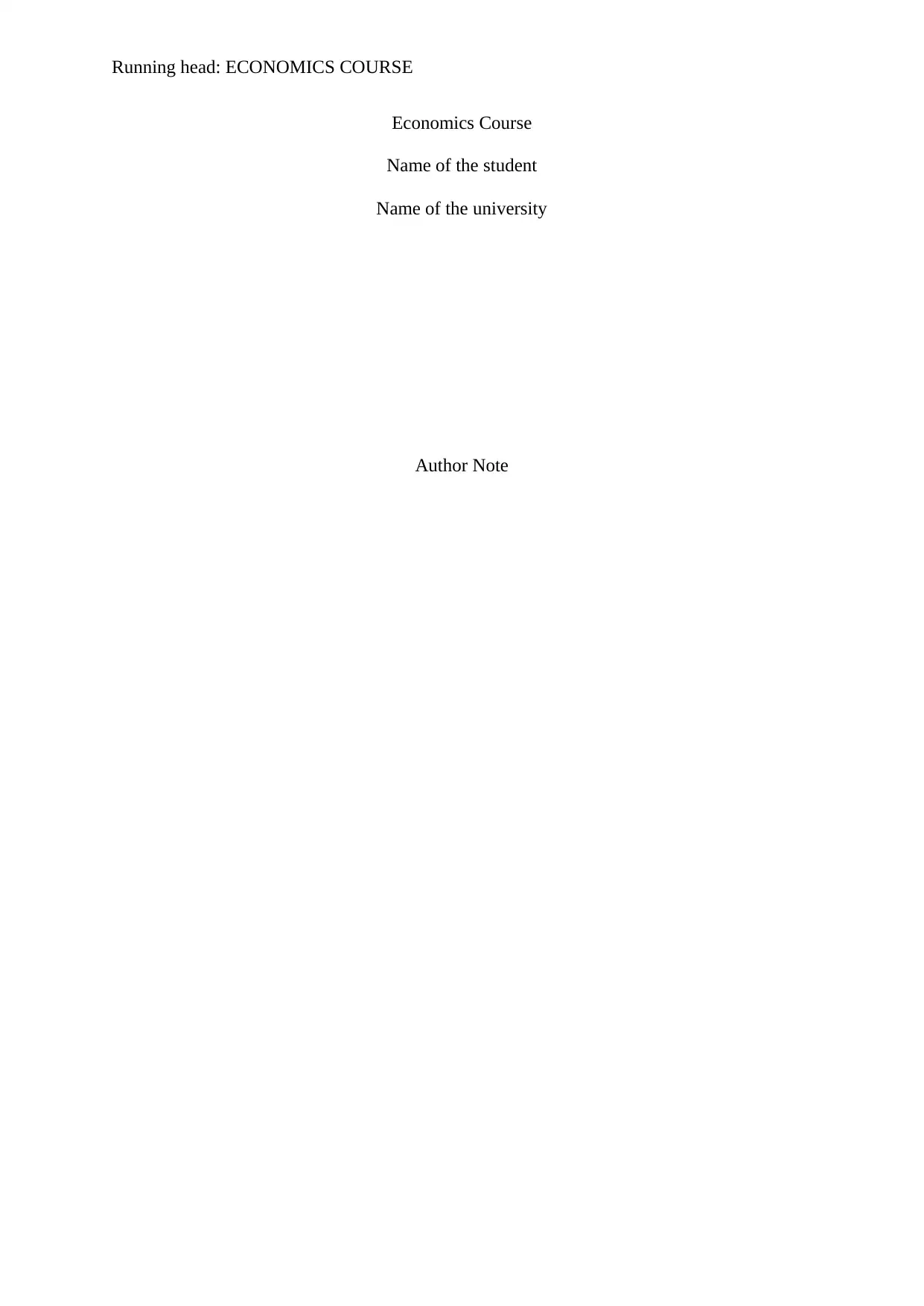
Running head: ECONOMICS COURSE
Economics Course
Name of the student
Name of the university
Author Note
Economics Course
Name of the student
Name of the university
Author Note
Secure Best Marks with AI Grader
Need help grading? Try our AI Grader for instant feedback on your assignments.

1ECONOMICS COURSE
Table of Contents
Section A:...................................................................................................................................3
Answer 1:...............................................................................................................................3
Answer 2:...............................................................................................................................3
a).............................................................................................................................................3
b)............................................................................................................................................5
c).............................................................................................................................................5
d)............................................................................................................................................6
e).............................................................................................................................................6
f).............................................................................................................................................6
Section B:...................................................................................................................................8
1)............................................................................................................................................8
2)............................................................................................................................................8
3)............................................................................................................................................9
4)............................................................................................................................................9
5)..........................................................................................................................................11
i)...........................................................................................................................................11
ii)..........................................................................................................................................12
Section C:.................................................................................................................................13
Q 1).......................................................................................................................................13
Q2)........................................................................................................................................14
Table of Contents
Section A:...................................................................................................................................3
Answer 1:...............................................................................................................................3
Answer 2:...............................................................................................................................3
a).............................................................................................................................................3
b)............................................................................................................................................5
c).............................................................................................................................................5
d)............................................................................................................................................6
e).............................................................................................................................................6
f).............................................................................................................................................6
Section B:...................................................................................................................................8
1)............................................................................................................................................8
2)............................................................................................................................................8
3)............................................................................................................................................9
4)............................................................................................................................................9
5)..........................................................................................................................................11
i)...........................................................................................................................................11
ii)..........................................................................................................................................12
Section C:.................................................................................................................................13
Q 1).......................................................................................................................................13
Q2)........................................................................................................................................14
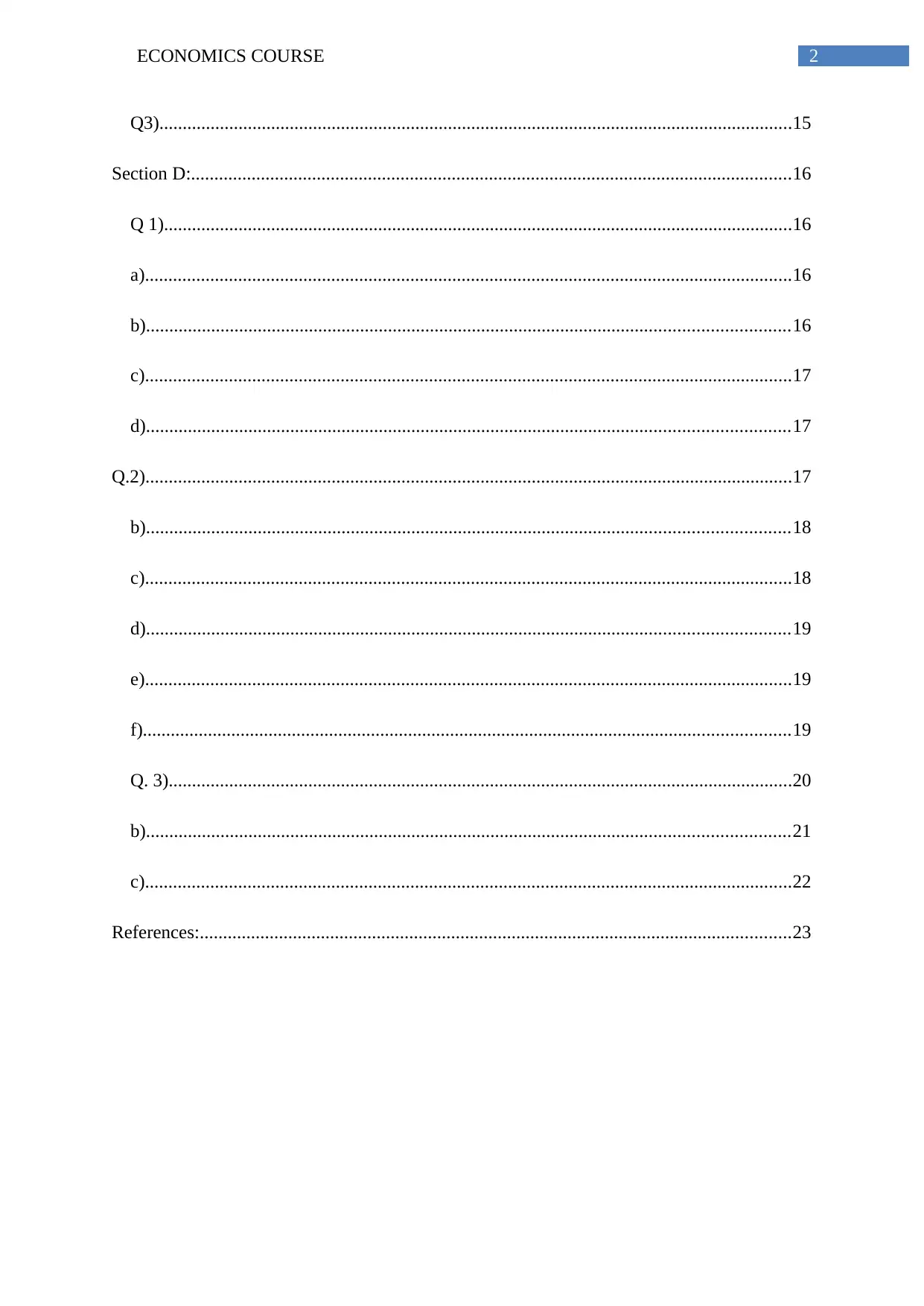
2ECONOMICS COURSE
Q3)........................................................................................................................................15
Section D:.................................................................................................................................16
Q 1).......................................................................................................................................16
a)...........................................................................................................................................16
b)..........................................................................................................................................16
c)...........................................................................................................................................17
d)..........................................................................................................................................17
Q.2)...........................................................................................................................................17
b)..........................................................................................................................................18
c)...........................................................................................................................................18
d)..........................................................................................................................................19
e)...........................................................................................................................................19
f)...........................................................................................................................................19
Q. 3)......................................................................................................................................20
b)..........................................................................................................................................21
c)...........................................................................................................................................22
References:...............................................................................................................................23
Q3)........................................................................................................................................15
Section D:.................................................................................................................................16
Q 1).......................................................................................................................................16
a)...........................................................................................................................................16
b)..........................................................................................................................................16
c)...........................................................................................................................................17
d)..........................................................................................................................................17
Q.2)...........................................................................................................................................17
b)..........................................................................................................................................18
c)...........................................................................................................................................18
d)..........................................................................................................................................19
e)...........................................................................................................................................19
f)...........................................................................................................................................19
Q. 3)......................................................................................................................................20
b)..........................................................................................................................................21
c)...........................................................................................................................................22
References:...............................................................................................................................23
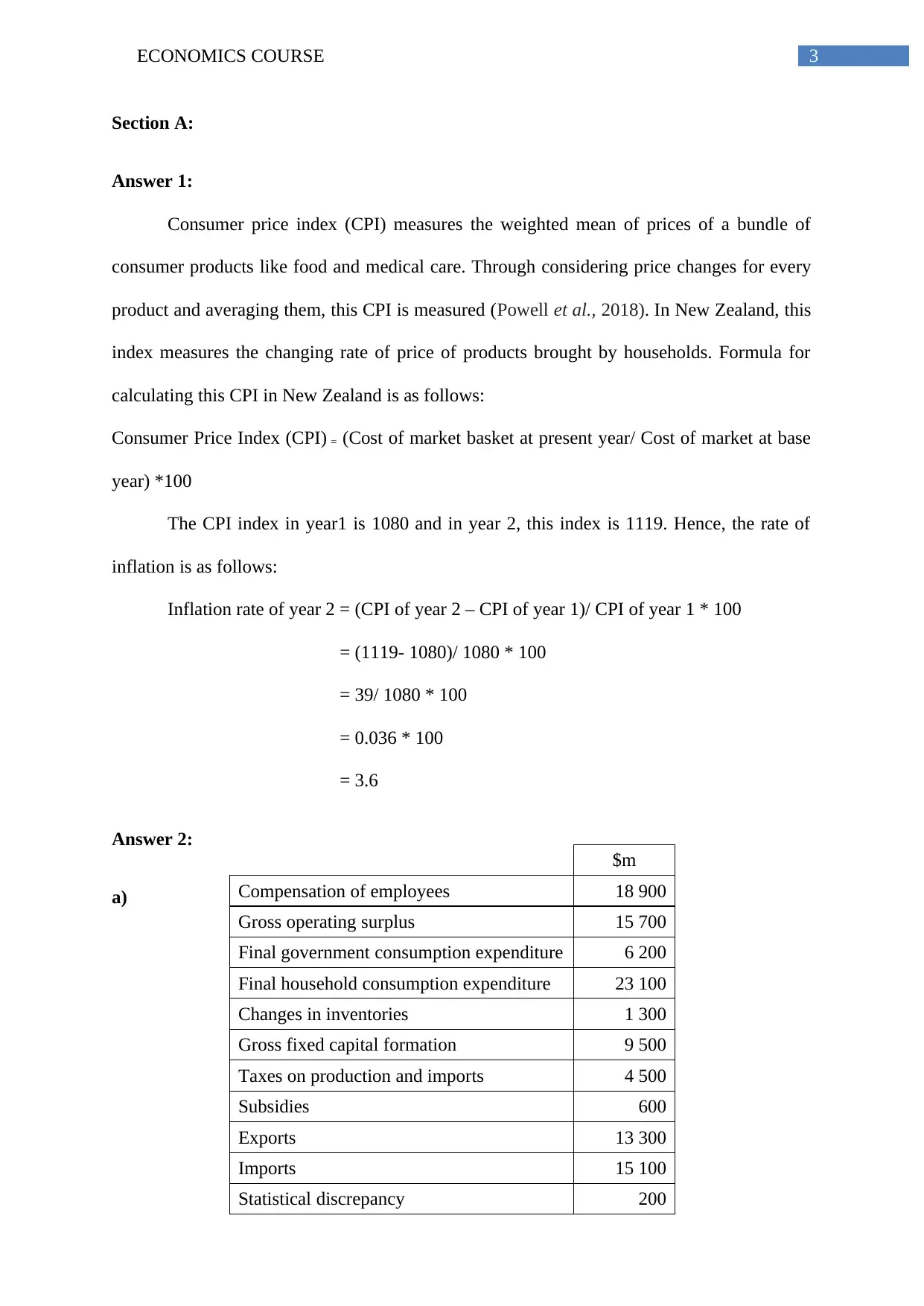
3ECONOMICS COURSE
Section A:
Answer 1:
Consumer price index (CPI) measures the weighted mean of prices of a bundle of
consumer products like food and medical care. Through considering price changes for every
product and averaging them, this CPI is measured (Powell et al., 2018). In New Zealand, this
index measures the changing rate of price of products brought by households. Formula for
calculating this CPI in New Zealand is as follows:
Consumer Price Index (CPI) = (Cost of market basket at present year/ Cost of market at base
year) *100
The CPI index in year1 is 1080 and in year 2, this index is 1119. Hence, the rate of
inflation is as follows:
Inflation rate of year 2 = (CPI of year 2 – CPI of year 1)/ CPI of year 1 * 100
= (1119- 1080)/ 1080 * 100
= 39/ 1080 * 100
= 0.036 * 100
= 3.6
Answer 2:
a)
$m
Compensation of employees 18 900
Gross operating surplus 15 700
Final government consumption expenditure 6 200
Final household consumption expenditure 23 100
Changes in inventories 1 300
Gross fixed capital formation 9 500
Taxes on production and imports 4 500
Subsidies 600
Exports 13 300
Imports 15 100
Statistical discrepancy 200
Section A:
Answer 1:
Consumer price index (CPI) measures the weighted mean of prices of a bundle of
consumer products like food and medical care. Through considering price changes for every
product and averaging them, this CPI is measured (Powell et al., 2018). In New Zealand, this
index measures the changing rate of price of products brought by households. Formula for
calculating this CPI in New Zealand is as follows:
Consumer Price Index (CPI) = (Cost of market basket at present year/ Cost of market at base
year) *100
The CPI index in year1 is 1080 and in year 2, this index is 1119. Hence, the rate of
inflation is as follows:
Inflation rate of year 2 = (CPI of year 2 – CPI of year 1)/ CPI of year 1 * 100
= (1119- 1080)/ 1080 * 100
= 39/ 1080 * 100
= 0.036 * 100
= 3.6
Answer 2:
a)
$m
Compensation of employees 18 900
Gross operating surplus 15 700
Final government consumption expenditure 6 200
Final household consumption expenditure 23 100
Changes in inventories 1 300
Gross fixed capital formation 9 500
Taxes on production and imports 4 500
Subsidies 600
Exports 13 300
Imports 15 100
Statistical discrepancy 200
Secure Best Marks with AI Grader
Need help grading? Try our AI Grader for instant feedback on your assignments.
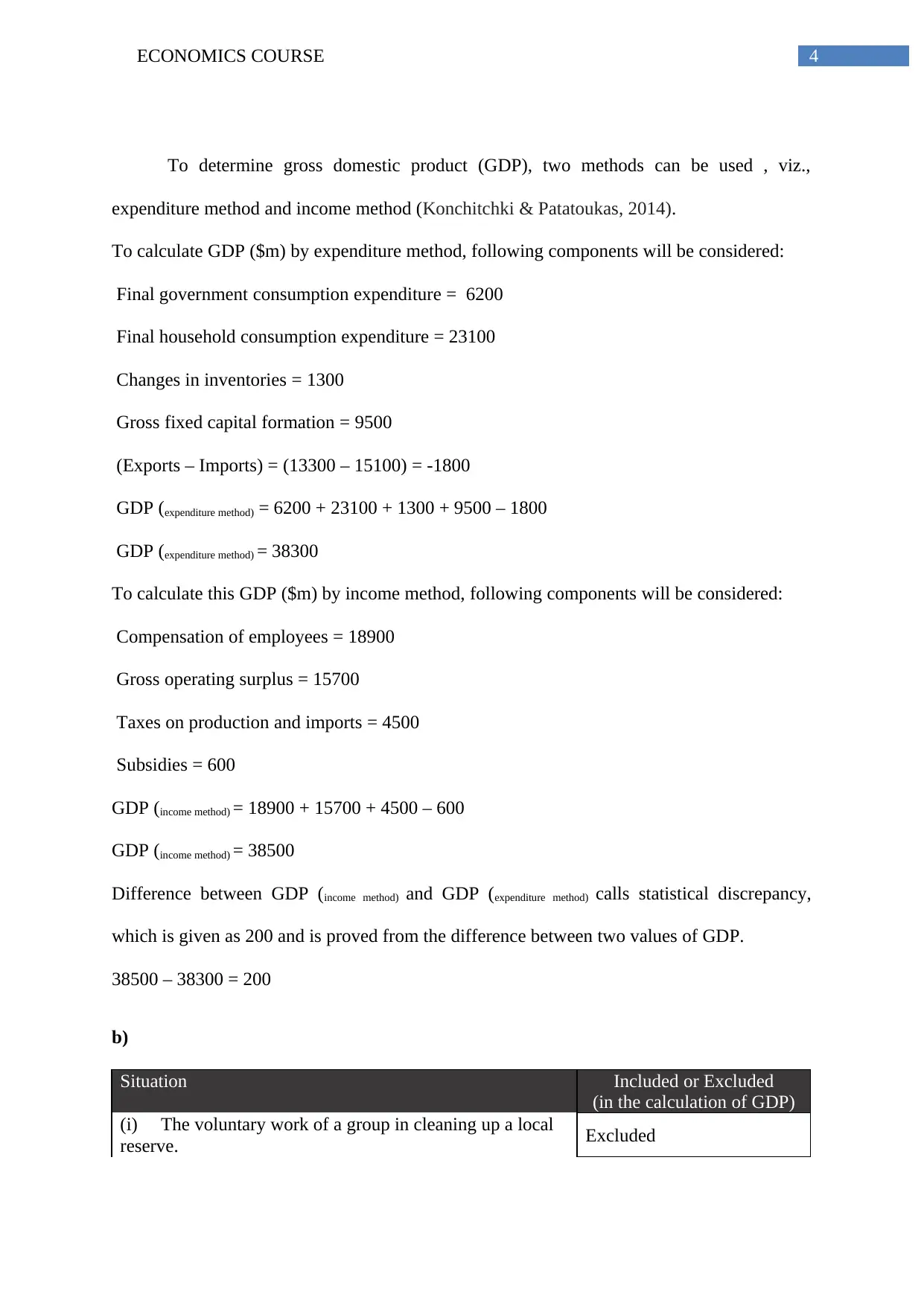
4ECONOMICS COURSE
To determine gross domestic product (GDP), two methods can be used , viz.,
expenditure method and income method (Konchitchki & Patatoukas, 2014).
To calculate GDP ($m) by expenditure method, following components will be considered:
Final government consumption expenditure = 6200
Final household consumption expenditure = 23100
Changes in inventories = 1300
Gross fixed capital formation = 9500
(Exports – Imports) = (13300 – 15100) = -1800
GDP (expenditure method) = 6200 + 23100 + 1300 + 9500 – 1800
GDP (expenditure method) = 38300
To calculate this GDP ($m) by income method, following components will be considered:
Compensation of employees = 18900
Gross operating surplus = 15700
Taxes on production and imports = 4500
Subsidies = 600
GDP (income method) = 18900 + 15700 + 4500 – 600
GDP (income method) = 38500
Difference between GDP (income method) and GDP (expenditure method) calls statistical discrepancy,
which is given as 200 and is proved from the difference between two values of GDP.
38500 – 38300 = 200
b)
Situation Included or Excluded
(in the calculation of GDP)
(i) The voluntary work of a group in cleaning up a local
reserve. Excluded
To determine gross domestic product (GDP), two methods can be used , viz.,
expenditure method and income method (Konchitchki & Patatoukas, 2014).
To calculate GDP ($m) by expenditure method, following components will be considered:
Final government consumption expenditure = 6200
Final household consumption expenditure = 23100
Changes in inventories = 1300
Gross fixed capital formation = 9500
(Exports – Imports) = (13300 – 15100) = -1800
GDP (expenditure method) = 6200 + 23100 + 1300 + 9500 – 1800
GDP (expenditure method) = 38300
To calculate this GDP ($m) by income method, following components will be considered:
Compensation of employees = 18900
Gross operating surplus = 15700
Taxes on production and imports = 4500
Subsidies = 600
GDP (income method) = 18900 + 15700 + 4500 – 600
GDP (income method) = 38500
Difference between GDP (income method) and GDP (expenditure method) calls statistical discrepancy,
which is given as 200 and is proved from the difference between two values of GDP.
38500 – 38300 = 200
b)
Situation Included or Excluded
(in the calculation of GDP)
(i) The voluntary work of a group in cleaning up a local
reserve. Excluded

5ECONOMICS COURSE
(ii) Activities of the underground economy. Excluded
(iii) The purchase of alcohol for a party. Included
(iv) The money spent on cleaning up the mess resulting
from a road accident and hospital care for injured
passengers.
Including
(v) The proceeds from illegal activities that do not go
through a market. Excluded
(vi) Spending by the government on new motorways out
of all the main centers. Including
(vii) A student renting a video for the weekend. Including
(viii) Non-market activity such as growing your own
vegetables or paving your own driveway. Excluding
(ix) A business upgrading its computer network. Excluding
(x) An electrician does the wiring for his neighbor (a
plumber) in exchange for unblocking his drain, i.e.
payments in kind.
Excluding
(xi) A builder build a block of flats. Including
(xii) Paying for electricity. Including
c)
Two reasons, where GDP understates the true level of economic activity can be
described as follows:
i) This indicator represents standard of living of a society however, this rough measurement
does not consider the direct account of environmental quality and leisure, standard of
education and health and changing inequality of income and so on (Feldstein, 2017).
ii) The GDP of any country does not consider non-market products as the economy produces
those goods but these are not exchanged in market.
d)
The chief difference between real GDP and nominal GDP is that the first type of GDP
indicator is inflation adjusted while the second one does not consider the value of inflation.
(ii) Activities of the underground economy. Excluded
(iii) The purchase of alcohol for a party. Included
(iv) The money spent on cleaning up the mess resulting
from a road accident and hospital care for injured
passengers.
Including
(v) The proceeds from illegal activities that do not go
through a market. Excluded
(vi) Spending by the government on new motorways out
of all the main centers. Including
(vii) A student renting a video for the weekend. Including
(viii) Non-market activity such as growing your own
vegetables or paving your own driveway. Excluding
(ix) A business upgrading its computer network. Excluding
(x) An electrician does the wiring for his neighbor (a
plumber) in exchange for unblocking his drain, i.e.
payments in kind.
Excluding
(xi) A builder build a block of flats. Including
(xii) Paying for electricity. Including
c)
Two reasons, where GDP understates the true level of economic activity can be
described as follows:
i) This indicator represents standard of living of a society however, this rough measurement
does not consider the direct account of environmental quality and leisure, standard of
education and health and changing inequality of income and so on (Feldstein, 2017).
ii) The GDP of any country does not consider non-market products as the economy produces
those goods but these are not exchanged in market.
d)
The chief difference between real GDP and nominal GDP is that the first type of GDP
indicator is inflation adjusted while the second one does not consider the value of inflation.

6ECONOMICS COURSE
Real GDP can measure the changes in price level and gives proper figure of economic growth
(Pan, Wang, Wang & Yang, 2018). Nominal GDP, on the other side, represents the value of
national income for a particular year considering inflation.
e)
Real GDP per capita measures total output of a country, which considers the gross
domestic product (GDP) divided by the number of population of that country (Feldstein,
2017). This measurement is useful as it can compare relative performance of different
countries.
Thus, Real per capita GDP = Real GDP / total population
f)
Two limitations of Real GDP per capita related to well-being:
Firstly, this real GDP per capita is an average concept and ignores the pattern of income
distribution of a country (Feldstein, 2017). Hence, a country with higher income inequality
may have higher GDP compare to other countries where GDP is low but income is equally
distributed.
Secondly, this per capita measure does not represent spending power of consumers. This is
because price level varies country wise.
Hence, from above two limitations it can be said that real GDP per capita cannot
measure well-being of a country.
Real GDP can measure the changes in price level and gives proper figure of economic growth
(Pan, Wang, Wang & Yang, 2018). Nominal GDP, on the other side, represents the value of
national income for a particular year considering inflation.
e)
Real GDP per capita measures total output of a country, which considers the gross
domestic product (GDP) divided by the number of population of that country (Feldstein,
2017). This measurement is useful as it can compare relative performance of different
countries.
Thus, Real per capita GDP = Real GDP / total population
f)
Two limitations of Real GDP per capita related to well-being:
Firstly, this real GDP per capita is an average concept and ignores the pattern of income
distribution of a country (Feldstein, 2017). Hence, a country with higher income inequality
may have higher GDP compare to other countries where GDP is low but income is equally
distributed.
Secondly, this per capita measure does not represent spending power of consumers. This is
because price level varies country wise.
Hence, from above two limitations it can be said that real GDP per capita cannot
measure well-being of a country.
Paraphrase This Document
Need a fresh take? Get an instant paraphrase of this document with our AI Paraphraser
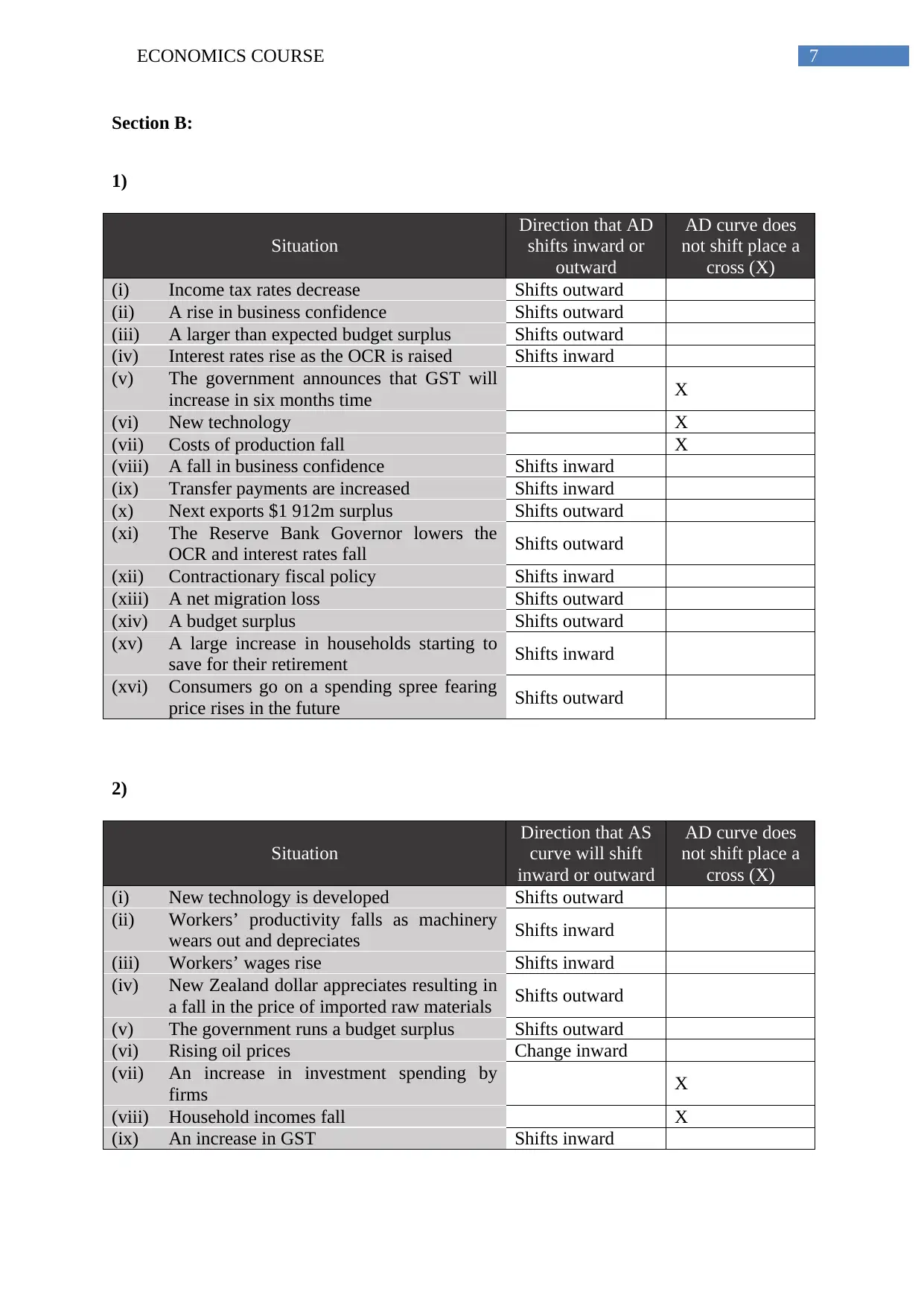
7ECONOMICS COURSE
Section B:
1)
Situation
Direction that AD
shifts inward or
outward
AD curve does
not shift place a
cross (X)
(i) Income tax rates decrease Shifts outward
(ii) A rise in business confidence Shifts outward
(iii) A larger than expected budget surplus Shifts outward
(iv) Interest rates rise as the OCR is raised Shifts inward
(v) The government announces that GST will
increase in six months time X
(vi) New technology X
(vii) Costs of production fall X
(viii) A fall in business confidence Shifts inward
(ix) Transfer payments are increased Shifts inward
(x) Next exports $1 912m surplus Shifts outward
(xi) The Reserve Bank Governor lowers the
OCR and interest rates fall Shifts outward
(xii) Contractionary fiscal policy Shifts inward
(xiii) A net migration loss Shifts outward
(xiv) A budget surplus Shifts outward
(xv) A large increase in households starting to
save for their retirement Shifts inward
(xvi) Consumers go on a spending spree fearing
price rises in the future Shifts outward
2)
Situation
Direction that AS
curve will shift
inward or outward
AD curve does
not shift place a
cross (X)
(i) New technology is developed Shifts outward
(ii) Workers’ productivity falls as machinery
wears out and depreciates Shifts inward
(iii) Workers’ wages rise Shifts inward
(iv) New Zealand dollar appreciates resulting in
a fall in the price of imported raw materials Shifts outward
(v) The government runs a budget surplus Shifts outward
(vi) Rising oil prices Change inward
(vii) An increase in investment spending by
firms X
(viii) Household incomes fall X
(ix) An increase in GST Shifts inward
Section B:
1)
Situation
Direction that AD
shifts inward or
outward
AD curve does
not shift place a
cross (X)
(i) Income tax rates decrease Shifts outward
(ii) A rise in business confidence Shifts outward
(iii) A larger than expected budget surplus Shifts outward
(iv) Interest rates rise as the OCR is raised Shifts inward
(v) The government announces that GST will
increase in six months time X
(vi) New technology X
(vii) Costs of production fall X
(viii) A fall in business confidence Shifts inward
(ix) Transfer payments are increased Shifts inward
(x) Next exports $1 912m surplus Shifts outward
(xi) The Reserve Bank Governor lowers the
OCR and interest rates fall Shifts outward
(xii) Contractionary fiscal policy Shifts inward
(xiii) A net migration loss Shifts outward
(xiv) A budget surplus Shifts outward
(xv) A large increase in households starting to
save for their retirement Shifts inward
(xvi) Consumers go on a spending spree fearing
price rises in the future Shifts outward
2)
Situation
Direction that AS
curve will shift
inward or outward
AD curve does
not shift place a
cross (X)
(i) New technology is developed Shifts outward
(ii) Workers’ productivity falls as machinery
wears out and depreciates Shifts inward
(iii) Workers’ wages rise Shifts inward
(iv) New Zealand dollar appreciates resulting in
a fall in the price of imported raw materials Shifts outward
(v) The government runs a budget surplus Shifts outward
(vi) Rising oil prices Change inward
(vii) An increase in investment spending by
firms X
(viii) Household incomes fall X
(ix) An increase in GST Shifts inward

8ECONOMICS COURSE
AD0
AD1
AS0
Price level
O Real GDP
AS1
3)
Figure 1: Affect on AD-AS curves due to increase in net immigration
Source: (created by author)
Net immigration can increase aggregate demand of a country and this in turn can shift
the AD curve outwards. This is because total expenditure of this economy may increase due
to increasing demand of people. Moreover, net immigration increases as most of the people
come for searching a job or for obtaining higher education (Mankiw & Reis, 2018). This in
turn increases labor force and. As a result, aggregate supply curve increases as well. Figure 1
represents this where AD curve shifts from AD0 to AD1. On the other side, aggregate supply
curve also increases from AS0 to AS1.
4)
Event AD-AS Model Effect on real GDP,
inflation (CPI). And
unemployment level
AD0
AD1
AS0
Price level
O Real GDP
AS1
3)
Figure 1: Affect on AD-AS curves due to increase in net immigration
Source: (created by author)
Net immigration can increase aggregate demand of a country and this in turn can shift
the AD curve outwards. This is because total expenditure of this economy may increase due
to increasing demand of people. Moreover, net immigration increases as most of the people
come for searching a job or for obtaining higher education (Mankiw & Reis, 2018). This in
turn increases labor force and. As a result, aggregate supply curve increases as well. Figure 1
represents this where AD curve shifts from AD0 to AD1. On the other side, aggregate supply
curve also increases from AS0 to AS1.
4)
Event AD-AS Model Effect on real GDP,
inflation (CPI). And
unemployment level

9ECONOMICS COURSE
A fall in business
confidence
Real GDP falls
Negative inflation
Unemployment rate
increases
A large increase in
households starting
to save for their
retirement
Real GDP falls
Negative inflation
Unemployment rate
increases
A rise in business
confidence
Real GDP increases
Inflation
Unemployment rate
increases
P
AS
AD1
AD0
YY0Y1
P
YY0Y1
P
Y
AS
AD0
AD1
Y1Y0
A fall in business
confidence
Real GDP falls
Negative inflation
Unemployment rate
increases
A large increase in
households starting
to save for their
retirement
Real GDP falls
Negative inflation
Unemployment rate
increases
A rise in business
confidence
Real GDP increases
Inflation
Unemployment rate
increases
P
AS
AD1
AD0
YY0Y1
P
YY0Y1
P
Y
AS
AD0
AD1
Y1Y0
Secure Best Marks with AI Grader
Need help grading? Try our AI Grader for instant feedback on your assignments.
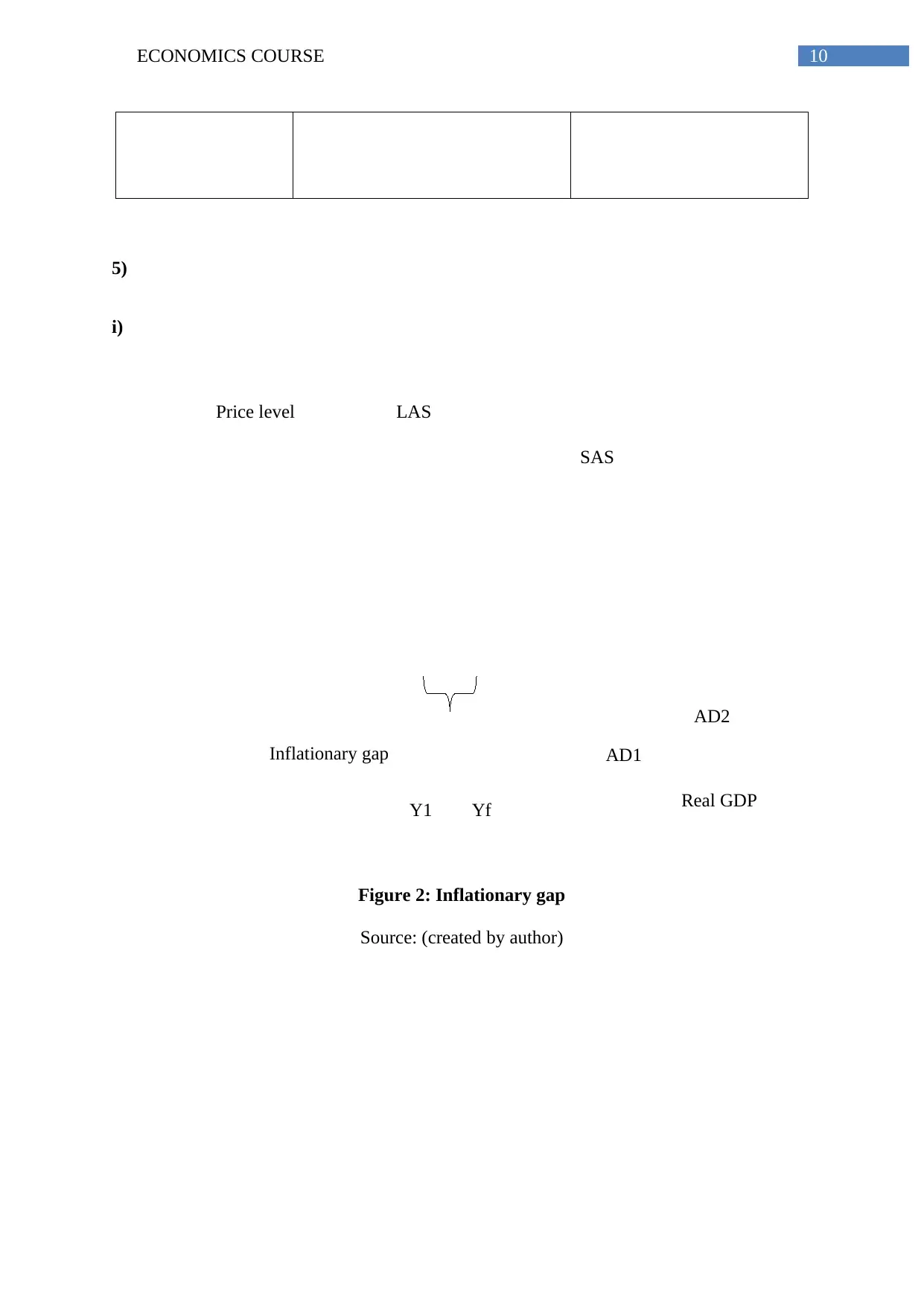
10ECONOMICS COURSE
AD1
SAS
Real GDP
Price level LAS
AD2
Y1 Yf
Inflationary gap
5)
i)
Figure 2: Inflationary gap
Source: (created by author)
AD1
SAS
Real GDP
Price level LAS
AD2
Y1 Yf
Inflationary gap
5)
i)
Figure 2: Inflationary gap
Source: (created by author)
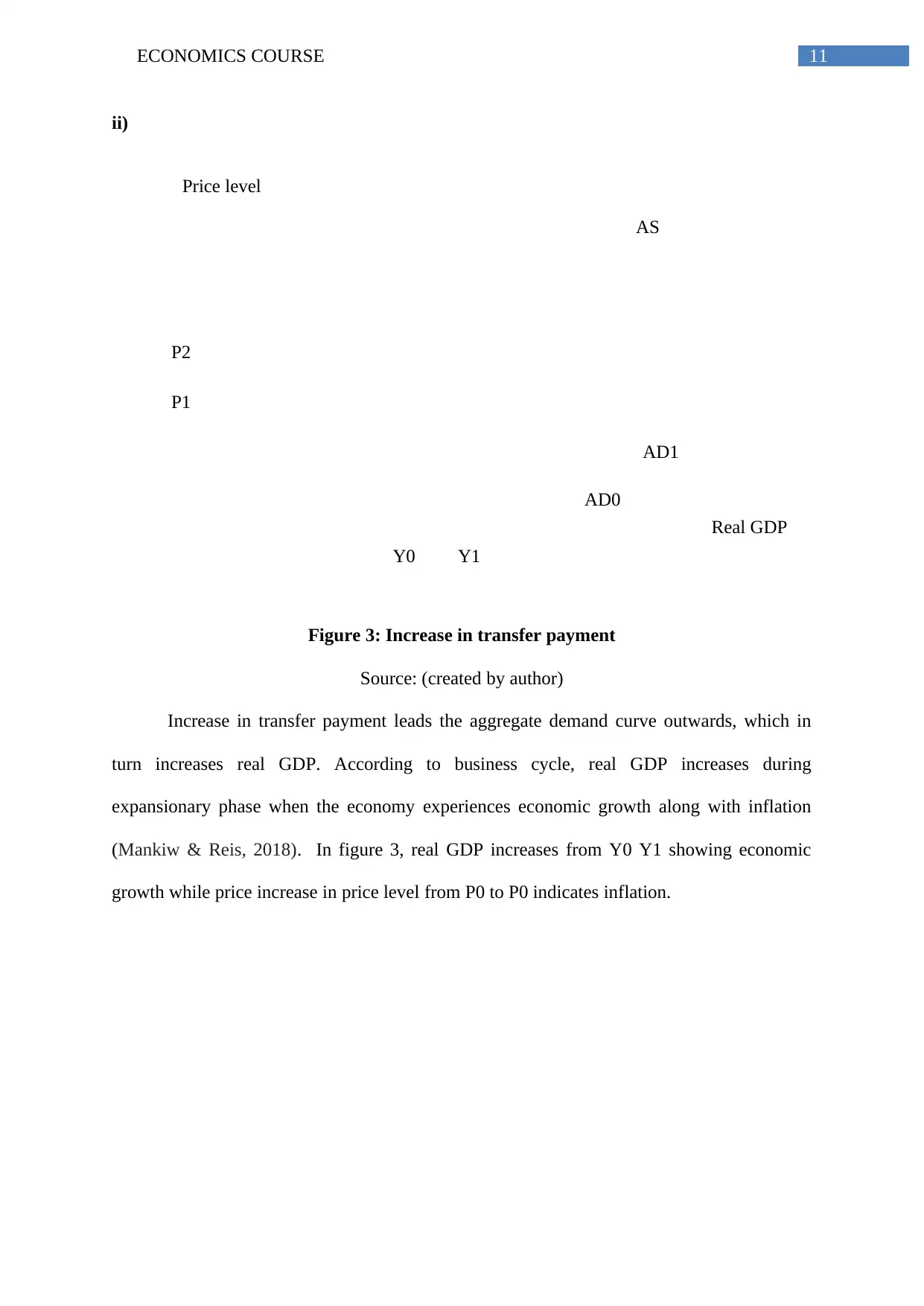
11ECONOMICS COURSE
AS
AD1
AD0
Price level
Real GDP
Y1Y0
P1
P2
ii)
Figure 3: Increase in transfer payment
Source: (created by author)
Increase in transfer payment leads the aggregate demand curve outwards, which in
turn increases real GDP. According to business cycle, real GDP increases during
expansionary phase when the economy experiences economic growth along with inflation
(Mankiw & Reis, 2018). In figure 3, real GDP increases from Y0 Y1 showing economic
growth while price increase in price level from P0 to P0 indicates inflation.
AS
AD1
AD0
Price level
Real GDP
Y1Y0
P1
P2
ii)
Figure 3: Increase in transfer payment
Source: (created by author)
Increase in transfer payment leads the aggregate demand curve outwards, which in
turn increases real GDP. According to business cycle, real GDP increases during
expansionary phase when the economy experiences economic growth along with inflation
(Mankiw & Reis, 2018). In figure 3, real GDP increases from Y0 Y1 showing economic
growth while price increase in price level from P0 to P0 indicates inflation.

12ECONOMICS COURSE
Section C:
Q 1)
Advantages:
Due to fastest economic growth in property market, consumers can receive more products,
which in turn can develop their standard of living. Moreover, poverty level will be reduced as
well.
Disadvantages:
i) Fastest growth of an economy increases the aggregate demand by large extend
compare to aggregate supply and consequently price level can increase further. This may
cause inflation within the economy.
ii) Economic growth in property market can generate environmental problems and
consequently negative externalities generate within the economy. Due to infrastructural
development, pollution can be generated as well.
Due to inflation, macroeconomic objective related to price stability and sustainable
economic growth cannot be achieved (Csereklyei, Thurner, Bauer & Küchenhoff, 2016). In
addition to this, negative externalities can also affect sustainable economic growth adversely.
Section C:
Q 1)
Advantages:
Due to fastest economic growth in property market, consumers can receive more products,
which in turn can develop their standard of living. Moreover, poverty level will be reduced as
well.
Disadvantages:
i) Fastest growth of an economy increases the aggregate demand by large extend
compare to aggregate supply and consequently price level can increase further. This may
cause inflation within the economy.
ii) Economic growth in property market can generate environmental problems and
consequently negative externalities generate within the economy. Due to infrastructural
development, pollution can be generated as well.
Due to inflation, macroeconomic objective related to price stability and sustainable
economic growth cannot be achieved (Csereklyei, Thurner, Bauer & Küchenhoff, 2016). In
addition to this, negative externalities can also affect sustainable economic growth adversely.
Paraphrase This Document
Need a fresh take? Get an instant paraphrase of this document with our AI Paraphraser

13ECONOMICS COURSE
AD0
AD1
AS
Price level
Real GDP
Q2)
Figure4: Increase in demand due to decrease in interest rate
Source: (created by author)
Reduction in OCR tends the aggregate demand curve of New Zealand outward
implying increase in demand from AD0 to AD1.
Monetary policy includes some actions that central bank of any country takes to
control monetary and financial situations for obtaining sustainable economic growth and low
level of inflation (Dosi et al., 2015).
Official Cash Rate (OCR) means the interest rate, which the central bank of New
Zealand set to meet the targeted inflation, specified in the policy targets Agreements (PTA).
The OCR affects the price related to borrowing money and helps the central bank of this
country to influence the inflation and economic activity.
In this given scenario, expansionary monetary policy has been conducted by
decreasing the interest rate. As a result, the economy of NZ can experience increase in
AD0
AD1
AS
Price level
Real GDP
Q2)
Figure4: Increase in demand due to decrease in interest rate
Source: (created by author)
Reduction in OCR tends the aggregate demand curve of New Zealand outward
implying increase in demand from AD0 to AD1.
Monetary policy includes some actions that central bank of any country takes to
control monetary and financial situations for obtaining sustainable economic growth and low
level of inflation (Dosi et al., 2015).
Official Cash Rate (OCR) means the interest rate, which the central bank of New
Zealand set to meet the targeted inflation, specified in the policy targets Agreements (PTA).
The OCR affects the price related to borrowing money and helps the central bank of this
country to influence the inflation and economic activity.
In this given scenario, expansionary monetary policy has been conducted by
decreasing the interest rate. As a result, the economy of NZ can experience increase in
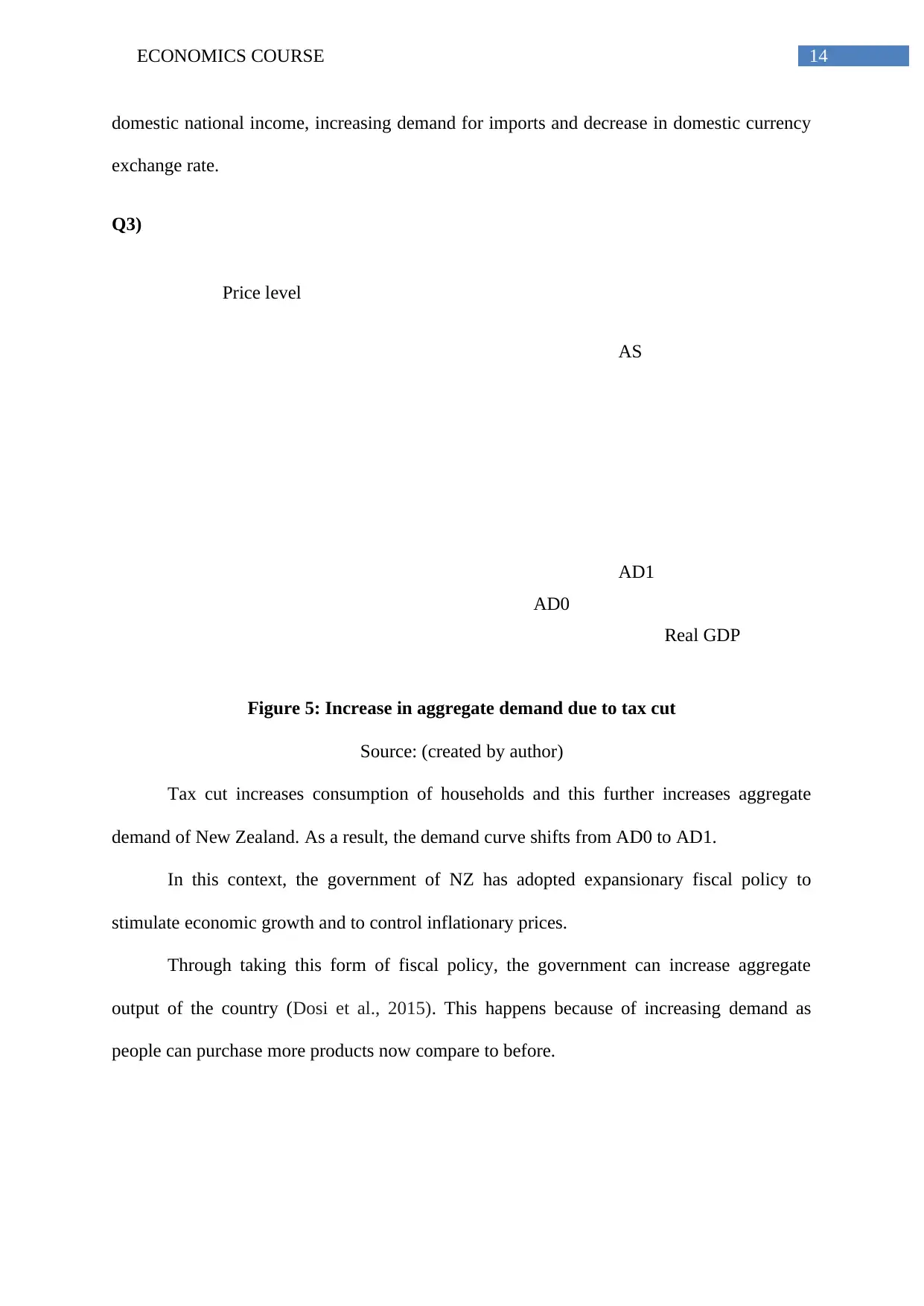
14ECONOMICS COURSE
AD0
AD1
AS
Price level
Real GDP
domestic national income, increasing demand for imports and decrease in domestic currency
exchange rate.
Q3)
Figure 5: Increase in aggregate demand due to tax cut
Source: (created by author)
Tax cut increases consumption of households and this further increases aggregate
demand of New Zealand. As a result, the demand curve shifts from AD0 to AD1.
In this context, the government of NZ has adopted expansionary fiscal policy to
stimulate economic growth and to control inflationary prices.
Through taking this form of fiscal policy, the government can increase aggregate
output of the country (Dosi et al., 2015). This happens because of increasing demand as
people can purchase more products now compare to before.
AD0
AD1
AS
Price level
Real GDP
domestic national income, increasing demand for imports and decrease in domestic currency
exchange rate.
Q3)
Figure 5: Increase in aggregate demand due to tax cut
Source: (created by author)
Tax cut increases consumption of households and this further increases aggregate
demand of New Zealand. As a result, the demand curve shifts from AD0 to AD1.
In this context, the government of NZ has adopted expansionary fiscal policy to
stimulate economic growth and to control inflationary prices.
Through taking this form of fiscal policy, the government can increase aggregate
output of the country (Dosi et al., 2015). This happens because of increasing demand as
people can purchase more products now compare to before.

15ECONOMICS COURSE
Section D:
Q 1)
OUTPUT PER WORKER PER ANNUM
WOOL FISH
NZ 60/90 = 0.67 90/60= 1.5
AUSTRALIA 50/30= 1.67 30/50= 0.6
According to the table, calculation of comparative advantage for New Zealand
60 wools cost 90 fish
1 wools cost 60/90 = 0.67 fishes
On the other side,
90 fishes cost 60 wools
1 fish costs 90/60 = 1.5 wools
For Australia,
50 wools cost 30 fish
1 wool cost 50/30 = 1.67 fishes
30 fish cost 50 wools
1 fish costs 30/50 = 0.6 wools
a)
According to this calculation, New Zealand has comparative advantage to produce
wools.
b)
Australia has comparative advantage to produce fish.
Section D:
Q 1)
OUTPUT PER WORKER PER ANNUM
WOOL FISH
NZ 60/90 = 0.67 90/60= 1.5
AUSTRALIA 50/30= 1.67 30/50= 0.6
According to the table, calculation of comparative advantage for New Zealand
60 wools cost 90 fish
1 wools cost 60/90 = 0.67 fishes
On the other side,
90 fishes cost 60 wools
1 fish costs 90/60 = 1.5 wools
For Australia,
50 wools cost 30 fish
1 wool cost 50/30 = 1.67 fishes
30 fish cost 50 wools
1 fish costs 30/50 = 0.6 wools
a)
According to this calculation, New Zealand has comparative advantage to produce
wools.
b)
Australia has comparative advantage to produce fish.
Secure Best Marks with AI Grader
Need help grading? Try our AI Grader for instant feedback on your assignments.
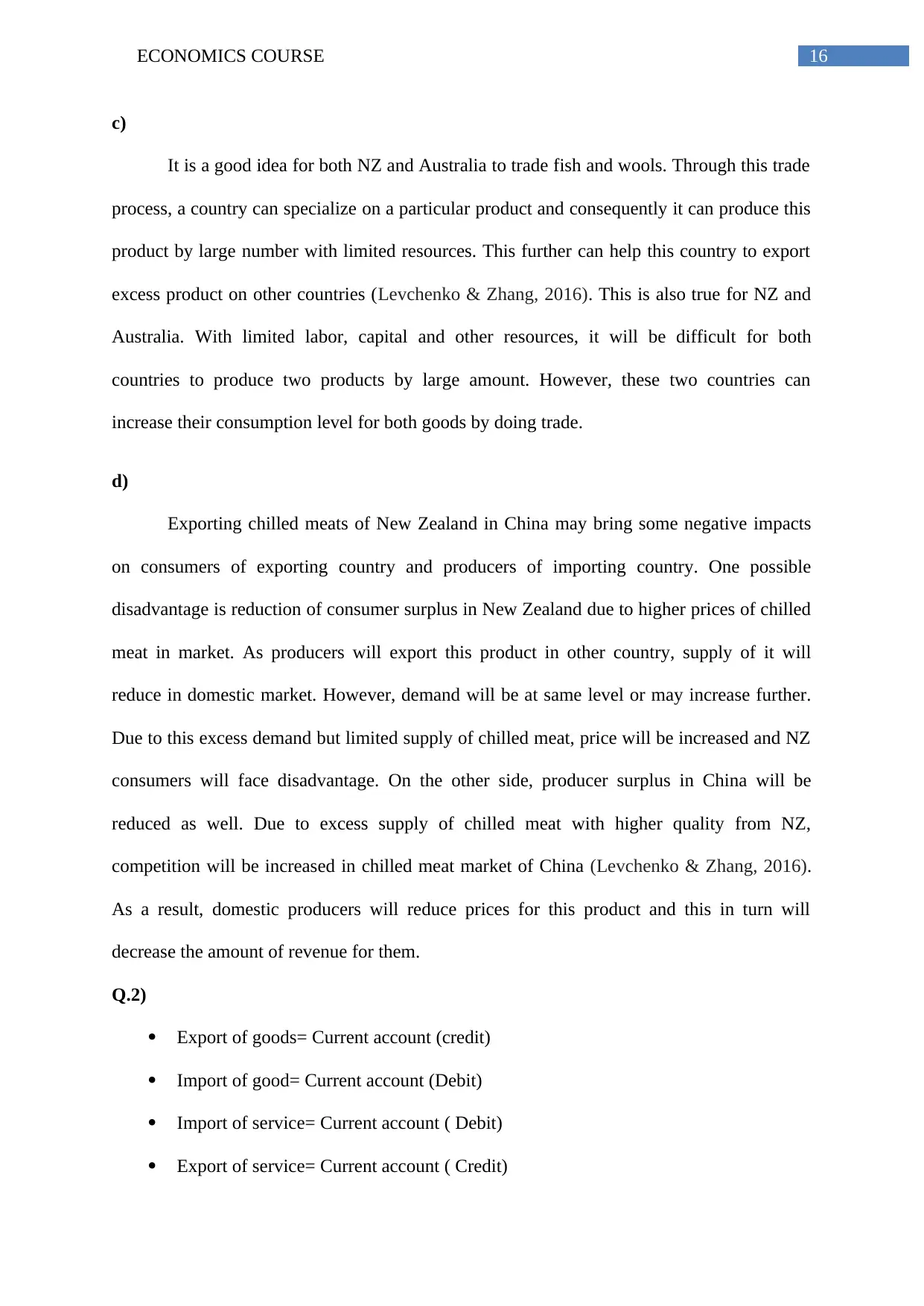
16ECONOMICS COURSE
c)
It is a good idea for both NZ and Australia to trade fish and wools. Through this trade
process, a country can specialize on a particular product and consequently it can produce this
product by large number with limited resources. This further can help this country to export
excess product on other countries (Levchenko & Zhang, 2016). This is also true for NZ and
Australia. With limited labor, capital and other resources, it will be difficult for both
countries to produce two products by large amount. However, these two countries can
increase their consumption level for both goods by doing trade.
d)
Exporting chilled meats of New Zealand in China may bring some negative impacts
on consumers of exporting country and producers of importing country. One possible
disadvantage is reduction of consumer surplus in New Zealand due to higher prices of chilled
meat in market. As producers will export this product in other country, supply of it will
reduce in domestic market. However, demand will be at same level or may increase further.
Due to this excess demand but limited supply of chilled meat, price will be increased and NZ
consumers will face disadvantage. On the other side, producer surplus in China will be
reduced as well. Due to excess supply of chilled meat with higher quality from NZ,
competition will be increased in chilled meat market of China (Levchenko & Zhang, 2016).
As a result, domestic producers will reduce prices for this product and this in turn will
decrease the amount of revenue for them.
Q.2)
Export of goods= Current account (credit)
Import of good= Current account (Debit)
Import of service= Current account ( Debit)
Export of service= Current account ( Credit)
c)
It is a good idea for both NZ and Australia to trade fish and wools. Through this trade
process, a country can specialize on a particular product and consequently it can produce this
product by large number with limited resources. This further can help this country to export
excess product on other countries (Levchenko & Zhang, 2016). This is also true for NZ and
Australia. With limited labor, capital and other resources, it will be difficult for both
countries to produce two products by large amount. However, these two countries can
increase their consumption level for both goods by doing trade.
d)
Exporting chilled meats of New Zealand in China may bring some negative impacts
on consumers of exporting country and producers of importing country. One possible
disadvantage is reduction of consumer surplus in New Zealand due to higher prices of chilled
meat in market. As producers will export this product in other country, supply of it will
reduce in domestic market. However, demand will be at same level or may increase further.
Due to this excess demand but limited supply of chilled meat, price will be increased and NZ
consumers will face disadvantage. On the other side, producer surplus in China will be
reduced as well. Due to excess supply of chilled meat with higher quality from NZ,
competition will be increased in chilled meat market of China (Levchenko & Zhang, 2016).
As a result, domestic producers will reduce prices for this product and this in turn will
decrease the amount of revenue for them.
Q.2)
Export of goods= Current account (credit)
Import of good= Current account (Debit)
Import of service= Current account ( Debit)
Export of service= Current account ( Credit)

17ECONOMICS COURSE
Investment income receipt= Capital account (credit)
Investment income payment= Capital account ( Debit)
Balance of current transfers= Current account (Credit)
Transactions Category
(i) Foreign tourist using domestic airline. Export of service
(ii) Premium paid to an overseas insurance company. Investment income receipt
(iii) Interest paid by domestic companies for foreign bank
loans.
Export of Service
(iv) Aluminium hub caps sold in Detroit by a New Zealand
firm.
Export of goods
(v) Foreign aid to a tsunami ravaged Pacific neighbor. Balance of current transfer
(vi) Dividends received by domestic shareholders from
overseas.
Investment income receipt
(vii) A New Zealand firm buys cars from Japan. Import of goods
(viii) A New Zealand flies on a plane operated by Singapore
Airlines.
Import of service
(ix) An Australian firm uses a New Zealand firm to ship its
produce to an Asian destination.
Import of service
b)
The current account of New Zealand can be affected positively after hosting the 2021
America’s cup. Through this event, the country can export its service to other countries and
this can increase the credit side of export service (Febrero, Uxó & Bermejo, 2018). Moreover,
foreign visitors will buy products along with match tickets in New Zealand and this will
increase the credit side of export of goods as well.
c)
Situation
Demand for
$NZ or supply
of $NZ?
Direction
of shift
Appreciation or
depreciation of
$NZ?
(i)
New Zealand tourist traveling
overseas Supply of $NZ
Supply
curve will
shift
rightward
Depreciation of
$NZ
(ii)
New Zealand importers paying
for raw materials Supply of $NZ
Supply
curve will
shift
rightward
Depreciation of
$NZ
Investment income receipt= Capital account (credit)
Investment income payment= Capital account ( Debit)
Balance of current transfers= Current account (Credit)
Transactions Category
(i) Foreign tourist using domestic airline. Export of service
(ii) Premium paid to an overseas insurance company. Investment income receipt
(iii) Interest paid by domestic companies for foreign bank
loans.
Export of Service
(iv) Aluminium hub caps sold in Detroit by a New Zealand
firm.
Export of goods
(v) Foreign aid to a tsunami ravaged Pacific neighbor. Balance of current transfer
(vi) Dividends received by domestic shareholders from
overseas.
Investment income receipt
(vii) A New Zealand firm buys cars from Japan. Import of goods
(viii) A New Zealand flies on a plane operated by Singapore
Airlines.
Import of service
(ix) An Australian firm uses a New Zealand firm to ship its
produce to an Asian destination.
Import of service
b)
The current account of New Zealand can be affected positively after hosting the 2021
America’s cup. Through this event, the country can export its service to other countries and
this can increase the credit side of export service (Febrero, Uxó & Bermejo, 2018). Moreover,
foreign visitors will buy products along with match tickets in New Zealand and this will
increase the credit side of export of goods as well.
c)
Situation
Demand for
$NZ or supply
of $NZ?
Direction
of shift
Appreciation or
depreciation of
$NZ?
(i)
New Zealand tourist traveling
overseas Supply of $NZ
Supply
curve will
shift
rightward
Depreciation of
$NZ
(ii)
New Zealand importers paying
for raw materials Supply of $NZ
Supply
curve will
shift
rightward
Depreciation of
$NZ
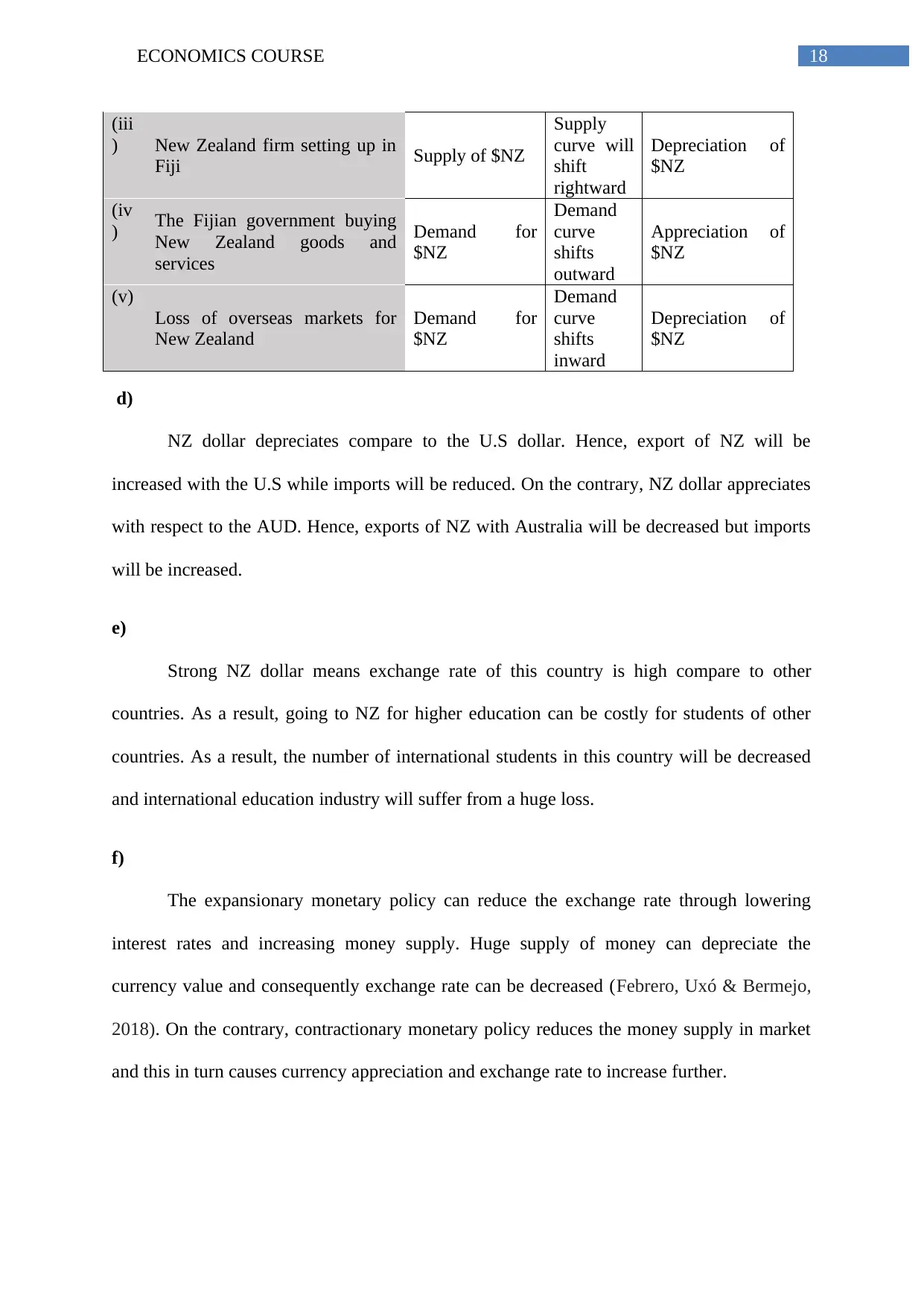
18ECONOMICS COURSE
(iii
) New Zealand firm setting up in
Fiji Supply of $NZ
Supply
curve will
shift
rightward
Depreciation of
$NZ
(iv
) The Fijian government buying
New Zealand goods and
services
Demand for
$NZ
Demand
curve
shifts
outward
Appreciation of
$NZ
(v)
Loss of overseas markets for
New Zealand
Demand for
$NZ
Demand
curve
shifts
inward
Depreciation of
$NZ
d)
NZ dollar depreciates compare to the U.S dollar. Hence, export of NZ will be
increased with the U.S while imports will be reduced. On the contrary, NZ dollar appreciates
with respect to the AUD. Hence, exports of NZ with Australia will be decreased but imports
will be increased.
e)
Strong NZ dollar means exchange rate of this country is high compare to other
countries. As a result, going to NZ for higher education can be costly for students of other
countries. As a result, the number of international students in this country will be decreased
and international education industry will suffer from a huge loss.
f)
The expansionary monetary policy can reduce the exchange rate through lowering
interest rates and increasing money supply. Huge supply of money can depreciate the
currency value and consequently exchange rate can be decreased (Febrero, Uxó & Bermejo,
2018). On the contrary, contractionary monetary policy reduces the money supply in market
and this in turn causes currency appreciation and exchange rate to increase further.
(iii
) New Zealand firm setting up in
Fiji Supply of $NZ
Supply
curve will
shift
rightward
Depreciation of
$NZ
(iv
) The Fijian government buying
New Zealand goods and
services
Demand for
$NZ
Demand
curve
shifts
outward
Appreciation of
$NZ
(v)
Loss of overseas markets for
New Zealand
Demand for
$NZ
Demand
curve
shifts
inward
Depreciation of
$NZ
d)
NZ dollar depreciates compare to the U.S dollar. Hence, export of NZ will be
increased with the U.S while imports will be reduced. On the contrary, NZ dollar appreciates
with respect to the AUD. Hence, exports of NZ with Australia will be decreased but imports
will be increased.
e)
Strong NZ dollar means exchange rate of this country is high compare to other
countries. As a result, going to NZ for higher education can be costly for students of other
countries. As a result, the number of international students in this country will be decreased
and international education industry will suffer from a huge loss.
f)
The expansionary monetary policy can reduce the exchange rate through lowering
interest rates and increasing money supply. Huge supply of money can depreciate the
currency value and consequently exchange rate can be decreased (Febrero, Uxó & Bermejo,
2018). On the contrary, contractionary monetary policy reduces the money supply in market
and this in turn causes currency appreciation and exchange rate to increase further.
Paraphrase This Document
Need a fresh take? Get an instant paraphrase of this document with our AI Paraphraser
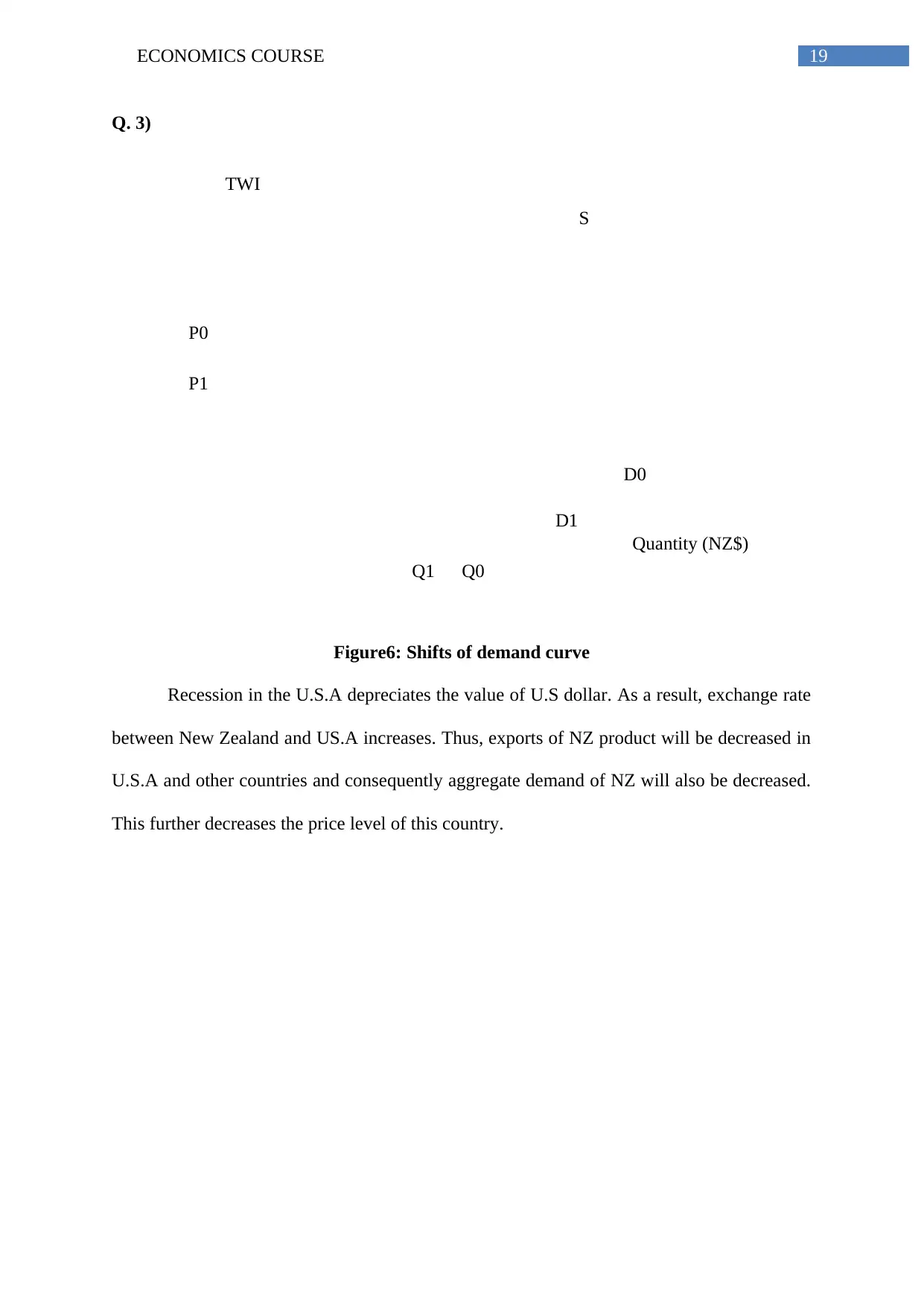
19ECONOMICS COURSE
TWI
Quantity (NZ$)
D1
S
D0
P0
P1
Q0Q1
Q. 3)
Figure6: Shifts of demand curve
Recession in the U.S.A depreciates the value of U.S dollar. As a result, exchange rate
between New Zealand and US.A increases. Thus, exports of NZ product will be decreased in
U.S.A and other countries and consequently aggregate demand of NZ will also be decreased.
This further decreases the price level of this country.
TWI
Quantity (NZ$)
D1
S
D0
P0
P1
Q0Q1
Q. 3)
Figure6: Shifts of demand curve
Recession in the U.S.A depreciates the value of U.S dollar. As a result, exchange rate
between New Zealand and US.A increases. Thus, exports of NZ product will be decreased in
U.S.A and other countries and consequently aggregate demand of NZ will also be decreased.
This further decreases the price level of this country.
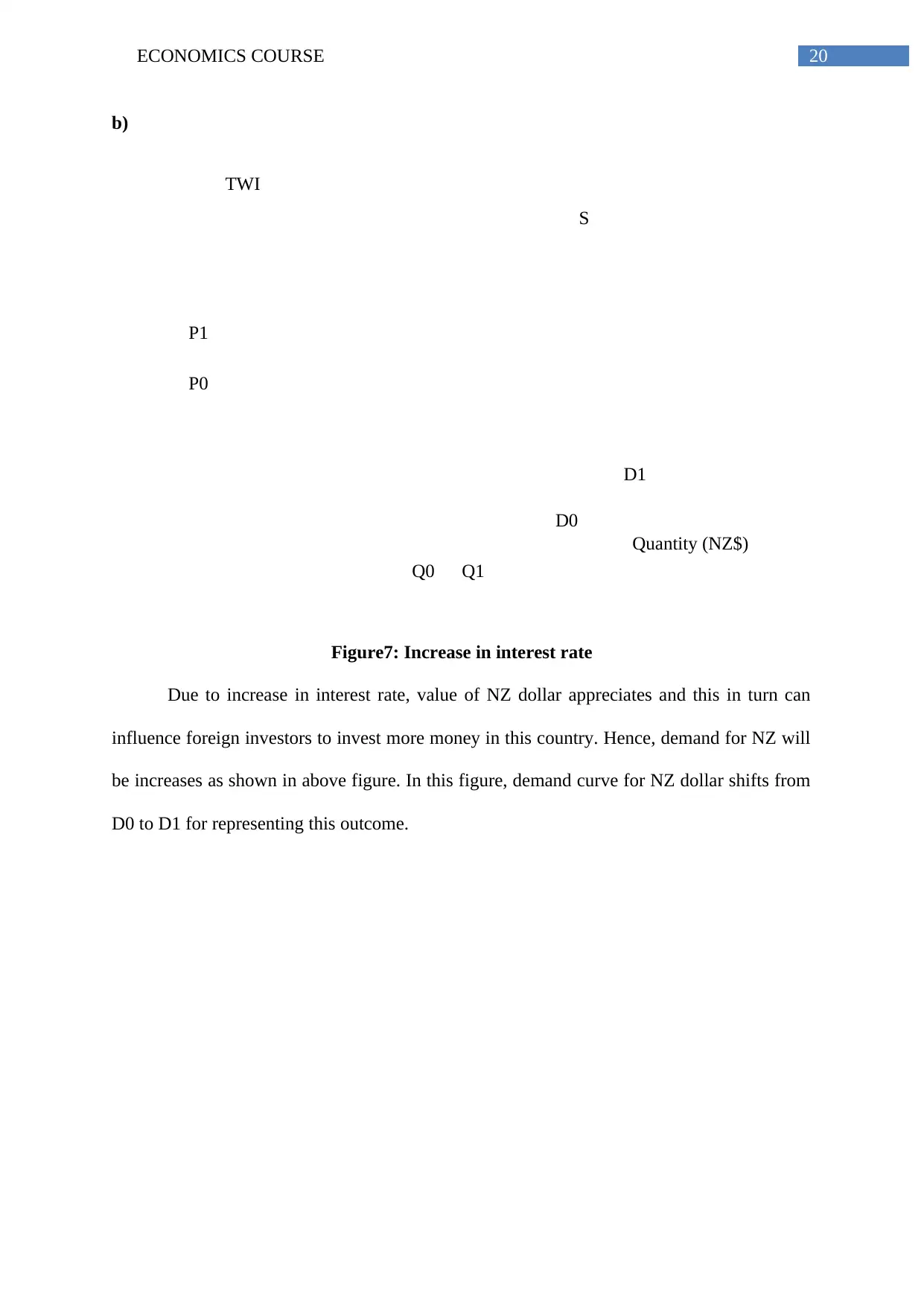
20ECONOMICS COURSE
TWI
Quantity (NZ$)
D0
S
D1
P1
P0
Q1Q0
b)
Figure7: Increase in interest rate
Due to increase in interest rate, value of NZ dollar appreciates and this in turn can
influence foreign investors to invest more money in this country. Hence, demand for NZ will
be increases as shown in above figure. In this figure, demand curve for NZ dollar shifts from
D0 to D1 for representing this outcome.
TWI
Quantity (NZ$)
D0
S
D1
P1
P0
Q1Q0
b)
Figure7: Increase in interest rate
Due to increase in interest rate, value of NZ dollar appreciates and this in turn can
influence foreign investors to invest more money in this country. Hence, demand for NZ will
be increases as shown in above figure. In this figure, demand curve for NZ dollar shifts from
D0 to D1 for representing this outcome.
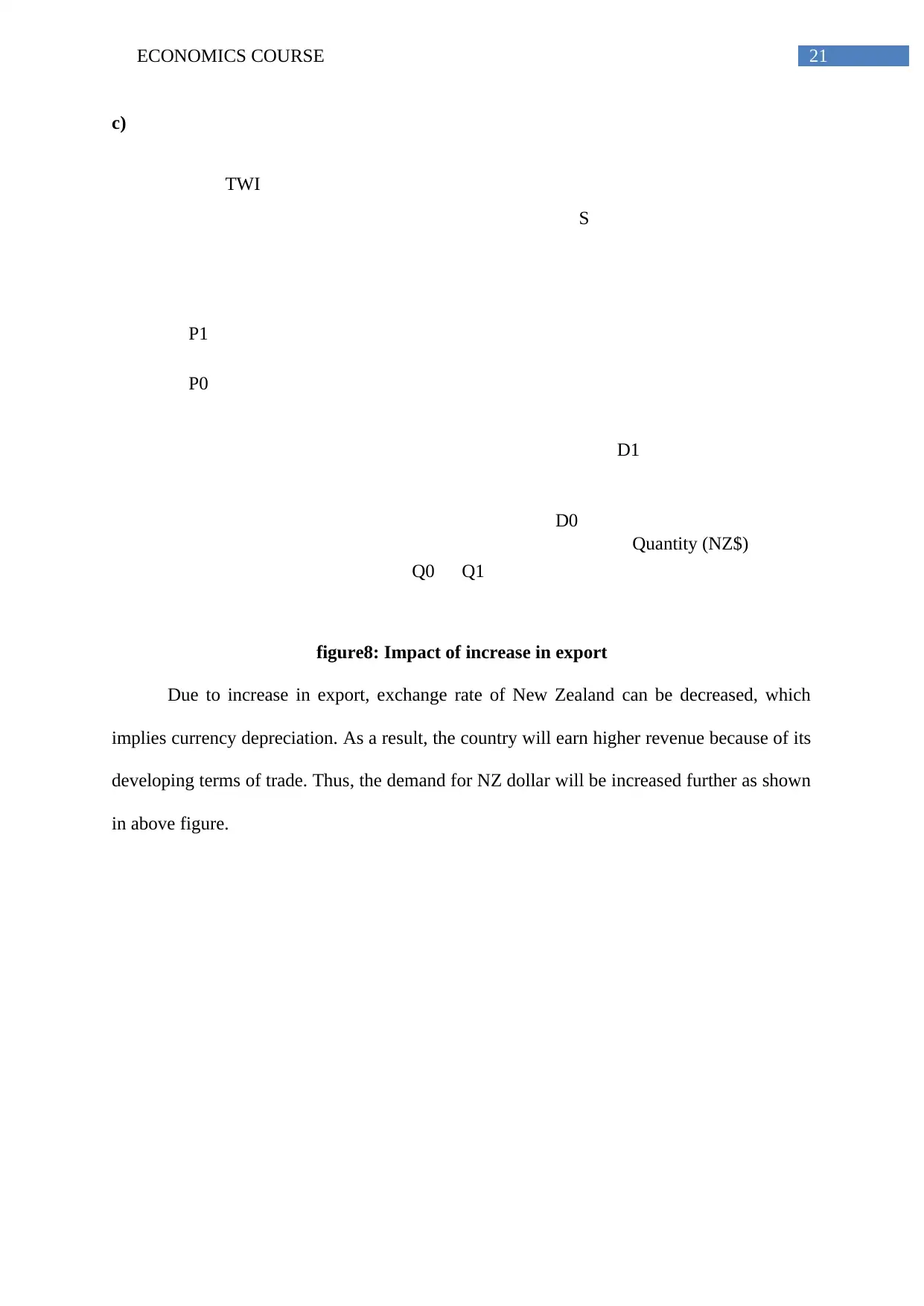
21ECONOMICS COURSE
TWI
Quantity (NZ$)
D0
S
P0
Q0
D1
Q1
P1
c)
figure8: Impact of increase in export
Due to increase in export, exchange rate of New Zealand can be decreased, which
implies currency depreciation. As a result, the country will earn higher revenue because of its
developing terms of trade. Thus, the demand for NZ dollar will be increased further as shown
in above figure.
TWI
Quantity (NZ$)
D0
S
P0
Q0
D1
Q1
P1
c)
figure8: Impact of increase in export
Due to increase in export, exchange rate of New Zealand can be decreased, which
implies currency depreciation. As a result, the country will earn higher revenue because of its
developing terms of trade. Thus, the demand for NZ dollar will be increased further as shown
in above figure.
Secure Best Marks with AI Grader
Need help grading? Try our AI Grader for instant feedback on your assignments.

22ECONOMICS COURSE
References:
Csereklyei, Z., Thurner, P. W., Bauer, A., & Küchenhoff, H. (2016). The effect of economic
growth, oil prices, and the benefits of reactor standardization: Duration of nuclear
power plant construction revisited. Energy Policy, 91, 49-59.
Dosi, G., Fagiolo, G., Napoletano, M., Roventini, A., & Treibich, T. (2015). Fiscal and
monetary policies in complex evolving economies. Journal of Economic Dynamics
and Control, 52, 166-189.
Febrero, E., Uxó, J., & Bermejo, F. (2018). The financial crisis in the eurozone: a balance-of-
payments crisis with a single currency?. Review of Keynesian Economics, 6(2), 221-
239.
Feldstein, M. (2017). Underestimating the real growth of GDP, personal income, and
productivity. Journal of Economic Perspectives, 31(2), 145-64.
Konchitchki, Y., & Patatoukas, P. N. (2014). Accounting earnings and gross domestic
product. Journal of Accounting and Economics, 57(1), 76-88.
Levchenko, A. A., & Zhang, J. (2016). The evolution of comparative advantage:
Measurement and welfare implications. Journal of Monetary Economics, 78, 96-111.
Mankiw, N. G., & Reis, R. (2018). Friedman's presidential address in the evolution of
macroeconomic thought. Journal of Economic Perspectives, 32(1), 81-96.
Pan, Z., Wang, Q., Wang, Y., & Yang, L. (2018). Forecasting US real GDP using oil prices:
A time-varying parameter MIDAS model. Energy Economics, 72, 177-187.
Powell, B., Nason, G., Elliott, D., Mayhew, M., Davies, J., & Winton, J. (2018). Tracking
and modelling prices using web‐scraped price microdata: towards automated daily
consumer price index forecasting. Journal of the Royal Statistical Society: Series A
(Statistics in Society), 181(3), 737-756.
References:
Csereklyei, Z., Thurner, P. W., Bauer, A., & Küchenhoff, H. (2016). The effect of economic
growth, oil prices, and the benefits of reactor standardization: Duration of nuclear
power plant construction revisited. Energy Policy, 91, 49-59.
Dosi, G., Fagiolo, G., Napoletano, M., Roventini, A., & Treibich, T. (2015). Fiscal and
monetary policies in complex evolving economies. Journal of Economic Dynamics
and Control, 52, 166-189.
Febrero, E., Uxó, J., & Bermejo, F. (2018). The financial crisis in the eurozone: a balance-of-
payments crisis with a single currency?. Review of Keynesian Economics, 6(2), 221-
239.
Feldstein, M. (2017). Underestimating the real growth of GDP, personal income, and
productivity. Journal of Economic Perspectives, 31(2), 145-64.
Konchitchki, Y., & Patatoukas, P. N. (2014). Accounting earnings and gross domestic
product. Journal of Accounting and Economics, 57(1), 76-88.
Levchenko, A. A., & Zhang, J. (2016). The evolution of comparative advantage:
Measurement and welfare implications. Journal of Monetary Economics, 78, 96-111.
Mankiw, N. G., & Reis, R. (2018). Friedman's presidential address in the evolution of
macroeconomic thought. Journal of Economic Perspectives, 32(1), 81-96.
Pan, Z., Wang, Q., Wang, Y., & Yang, L. (2018). Forecasting US real GDP using oil prices:
A time-varying parameter MIDAS model. Energy Economics, 72, 177-187.
Powell, B., Nason, G., Elliott, D., Mayhew, M., Davies, J., & Winton, J. (2018). Tracking
and modelling prices using web‐scraped price microdata: towards automated daily
consumer price index forecasting. Journal of the Royal Statistical Society: Series A
(Statistics in Society), 181(3), 737-756.
1 out of 23
Related Documents
Your All-in-One AI-Powered Toolkit for Academic Success.
+13062052269
info@desklib.com
Available 24*7 on WhatsApp / Email
![[object Object]](/_next/static/media/star-bottom.7253800d.svg)
Unlock your academic potential
© 2024 | Zucol Services PVT LTD | All rights reserved.



